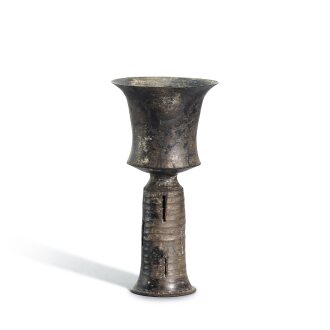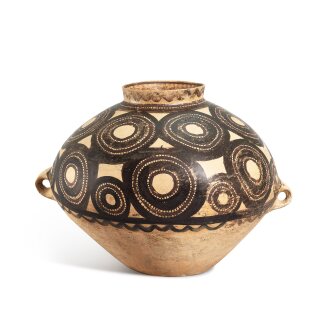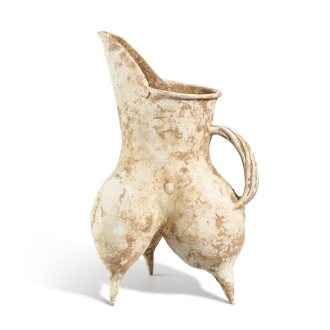“For thousands of years before the bronze age, pottery and stone were the most important materials in prehistoric cultures all over the world. They were used to create utilitarian objects and moving works of art.”
I n the early 1920s, an expedition led by Swedish archaeologist Johan Gunnar Andersson into the rural village Yangshao of Henan province in central China led to the first documented findings of distinctive Neolithic settlement. Over the decades following Andersson’s discovery, subsequent excavations in Yangshao and elsewhere led to the unearthing of prehistoric burial complexes along with troves of pottery, stone objects, artefacts, and remains of no fewer than 60 distinct Neolithic cultures. The collection of Ronald W. Longsdorf presents sophisticated ceramic works from a range of settlements of the Neolithic period – from the various phases of Yangshao, offering a broad view of the central plains along the Yellow River, to contemporary parallels from sites on the eastern coast and the Yangzi River basin, such as Dawenkou, or later Longshan and Liangzhu cultures.

Neolithic pottery may be the most elemental medium of fine art. Longsdorf, whose metier is product design, emphasises in his connoisseurship both a functional and an aesthetic approach to Neolithic Chinese ceramic forms. In his appreciation of painted iconography, abstract and representational designs are allowed to remain self-evident without conjecture on spiritual meaning. While the purpose of some objects remains shrouded in mystery, taken together they point to an artistic tradition millennia past. Whether made for daily use or reserved for burial rites, these vessels of fired earth offer a glimpse into a way of life just as early humans were making the transition from hunter-gatherer to farming societies. They offer evidence of the technological know-how of various Neolithic cultures extending as far back as the fifth millennium BCE, advancing to the rise of bronze metallurgy circa second millennium BCE.


Source: Regina Krahl, Chinese Ceramics from the Meiyintang Collection, Vol. III, London, 2006, pp. xii-xiii
An extremely rare red pottery human-form bottle vase Yangshao culture, Banpo phase, 4800-3500 B.C.

The Art of Simplicity
“Even if Neolithic man was not familiar with the elegant equations of geometry and trigonometry… he seems to have had an instinctive appreciation for the graphic power of forms they describe. Geometric designs can produce an immediate sense of order, precision, lucidity, and balance, as they do here. A far cry from chaos and uncertainty.”
The presence of the spare sculptural forms and geometric patterns may originate in the human instinct for order, harmony, and proportion. Employing the forms of hard-edged squares and rectangles or dots with open circles, the designs express non-hierarchical abstract compositions detached from narrative or overt external references, focusing instead on the art object’s literal presence. Monochromatic vessels displaying dense patterns of ‘pricked’ notches favoured materiality and precision. Neolithic works from Banpo may strike our modern eyes as distinctly contemporary in design, as the emergence of Minimalism in art from the 1960s brought this back full circle thousands of years later, rejecting dramatic gestures in favour of a pared-down style of purely self-referential geometric forms.

The Neolithic age occurred about 10,000 years ago at the point when nomadic hunter-gatherers of the Paleolithic relied less on their spears and nets as they turned to sedentary farming, according to Regina Krahl as quoted in The Pottery Age An Appreciation of Neolithic Ceramics from China’ (P. 13). In adopting a lifestyle centring around agricultural settlements, the New Stone Age farmers, Krahl writes, “[shifted to a] more conscious utilisation of natural resources than had previously been the case. Evidence of farming and the domestication of animals can be documented for the region of China from the 7th millennium BC…. The vast territory today called China was during that time inhabited by many different cultures at varying stages of development. To some extent they influenced each other, but were equally in touch with cultures beyond China’s present borders.”
Fishing is an ever-present motif in Neolithic design suggested by the wave patterns that resemble water and double triangles signifying fish, or the inlay of shells that directly apply ocean forms to the vessel. The motivation may not be to achieve figurative or naturalistic depictions; rather they approximate the essential features such as texture, materiality, shape, and patterns. For example, we may observe the dense crisscross embellishments painted on a vessel and recognise them as an imaginative rendering of the fishing net, which had already been an innovation in Neolithic cultures, or perhaps they might replicate the plate-like scale pattern of the fish.
Soil samples from the archaeological settlements as well as painted designs on the vessels reveal that the earliest domesticated animals were likely dogs, water buffalo, and pig. The pig is, perhaps, the most well represented animal in Neolithic pottery, gesturing towards its centrality in agriculture. Neolithic artisans would paint the most salient features of the animal – namely, the characteristic snout and well-defined nostrils, or rounded stout bodies with minimal head-body differentiation. The prominence of dots and circles motif, suggestive of a round figure penned into an enclosure, points to the multiregional pig domestication as a life way in Neolithic China.

“Neolithic renderings of humans, in drawing or sculpture, can have a powerful effect on modern viewers, by bringing them face to face with fellow human beings from thousands of years ago.”
The pottery and stone objects unearthed from the Neolithic settlements are all that remain of a world which no longer exists. And yet, these remnants bring us into direct contact with the shapes of the natural world thousands of years ago. By the fifth millennium BCE, artisans had achieved sophistication in pottery which had would take diverse forms signaling the development of specialised functional vessels. Nature and the village environs would present ready inspiration, and vessels would assume these shapes even when they were not demanded by function or ergonomics.
Consider a ‘red’ pottery bottle the pear-shaped body rising to a waisted neck surmounted by a bulbous mouth sculpted to represent a humanoid head. The head does not appear to serve any function, and yet the design is striking. Longsdorf writes: “The bottle is well designed. The shape, both visually and functionally, has a strong and weighty base to counterbalance the long, thin, elegant neck.” (The Pottery Age, An Appreciation of Neolithic Ceramics from China, P.32) It is not difficult to imagine this form as an antecedent evolving in the abstract into later classic shapes such as the double gourd or ‘garlic-head’ gourd.
We find abstract avian forms in what is sometimes called the ‘nesting bird shape’ taking, as the name suggests, the form of a rounded bird body, tapered tail and an offset neck. This shape might also be interpreted as the form of a low boot, as there are some similar vessels that have been sculpted to resemble the human foot or footwear.
A rare painted pottery human-head jar Majiayao culture, Machang phase, c. 2200-2000 B.C.

Tripod ewers appear in various cultures such as the Dawenkou, Longshan, Qijia and Erlitou, and a comparison of the vessels reveal a progression of the form. The shape is typically composed of a collar and a spout connected to a generously curved body supported on three mammiform legs and formed on one side with a handle joined to the body. The coil-built, hollow legs were a technical innovation which allowed for direct contact over a fire bed with even distribution of heat across a maximal surface area. The significance of this ancient shape is far more than just functional, however, and has endured as a form through later periods of Chinese art history. Within the variations of the tripod shape, examples from the Neolithic period take on notable zoomorphic features. Whereas some scholars suggest that the tripod legs resemble the udders of milch animals, viewed from a different way, the ewer might resemble a wild bird as its beak and outstretched throat assume the form spout and neck, while its two legs and tail form the tripod.
Longsdorf reminds us that Neolithic ceramic forms: “took generations, sometimes centuries, to develop. At any moment in time, the Neolithic potters were doing their best to accurately reproduce the ceramic prototypes of their culture, taught to them by their community, not inventing new ones. But the countless iterations and subconscious alterations which occurred over time, viewed in the foreshortened lens of history inevitably produced innovations.” (‘The Pottery Age, An Appreciation of Neolithic Ceramics from China’, P. 15) The repetition and progression of Neolithic ceramic forms, such as the tripod ewer, would evolve through the dawn of the Bronze Age into what we now understand to be classic forms of archaic ritual bronzes. The Neolithic prototypes were the precursors to the staple shapes that would endure through millennia of Chinese art history.
- Humanoid
- Human face
- Bird
- Owl
- Avian Forms
- Bronze Age Tripod ewers
-
 An extremely rare red pottery human-form bottle vase Yangshao culture, Banpo phase, 4800-3500 B.C.
An extremely rare red pottery human-form bottle vase Yangshao culture, Banpo phase, 4800-3500 B.C. -
 A large painted human-face pouring vessel Majiayao culture
A large painted human-face pouring vessel Majiayao culture -
 A superb pair of red pottery bird-form vessels Qijia culture, c. 2050-1700 B.C.
A superb pair of red pottery bird-form vessels Qijia culture, c. 2050-1700 B.C. -
 A black pottery owl-form ewer Qijia culture, c. 2050-1700 B.C.
A black pottery owl-form ewer Qijia culture, c. 2050-1700 B.C. -
 A red pottery tripod ewer Dawenkou culture, c. 4300-2400 B.C.
A red pottery tripod ewer Dawenkou culture, c. 4300-2400 B.C. -
 A white pottery tripod ewer Early Bronze Age, Xia dynasty, 2nd millennium B.C.
A white pottery tripod ewer Early Bronze Age, Xia dynasty, 2nd millennium B.C.

Early potting methods involved hand-shaping of vessels, which typically involve a technique of pinching and looping coils of clay. The pottery of various Neolithic cultures would feature distinctive characteristics based on these methods, as well as the type of clay available, and the designs featured. The Neolithic cultures of eastern China produced grey and black vessels that are distinctive for their shapes and colour, characteristics that set them in contrast with the styles of ceramic wares created of the central plains. The Dawenkou culture developed a style of black or grey pottery made of very fine clay, with notable works that including elegant stem cups embellished with delicate openwork carving. The succeeding Longshan culture developed stylistically from there, becoming ever more refined. Described as ‘eggshell’ pottery, these vessels from Longshan are so named today because of the even potting, paper-thin walls and glossy black sheen. To achieve this effect, the use of the potter's wheel was a technological breakthrough during this period which enabled more sophisticated forming than the coil-built method traditionally used. According to Regina Krahl: “The Longshan potters exploited this new technique to create eggshell-thin vessels of breathtaking elegance, shaving the walls to minimal thickness with the help of a tool. To emphasize the appearance of weightlessness, these feather-light vessels were in addition pierced with openwork.” (Chinese Ceramics from the Meiyintang Collection, vol. 3 (I), London, 2006. Krahl, p. 46)





























